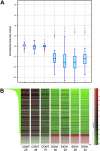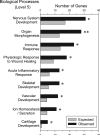Effects of moderate drinking during pregnancy on placental gene expression
- PMID: 20053520
- PMCID: PMC3654802
- DOI: 10.1016/j.alcohol.2009.10.002
Effects of moderate drinking during pregnancy on placental gene expression
Abstract
Many children adversely affected by maternal drinking during pregnancy cannot be identified early in life using current diagnostic criteria for fetal alcohol spectrum disorder (FASD). We conducted a preliminary investigation to determine whether ethanol-induced alterations in placental gene expression may have some utility as a diagnostic indicator of maternal drinking during pregnancy and as a prognostic indicator of risk for adverse neurobehavioral outcomes in affected offspring. Pregnant Long-Evans rats voluntarily consumed either a 0 or 5% ethanol solution 4 h each day throughout gestation. Ethanol consumption produced a mean maternal daily intermittent peak serum ethanol concentration of 84 mg/dL. Placentas were harvested on gestational day 20 for gene expression studies. Microarray analysis of more than 28,000 genes revealed that the expression of 304 known genes was altered twofold or greater in placenta from ethanol-consuming dams compared with controls. About 76% of these genes were repressed in ethanol-exposed placentas. Gene expression changes involved proteins associated with central nervous system development; organ morphogenesis; immunological responses; endocrine function; ion homeostasis; and skeletal, cardiovascular, and cartilage development. To date, quantitative real-time polymerase chain reaction analysis has confirmed significant alterations in gene expression for 22 genes, including genes encoding for three calcium binding proteins, two matrix metalloproteinases, the cannabinoid 1, galanin 2 and toll-like receptor 4, iodothyronine deiodinase 2, 11-β hydroxysteroid dehydrogenase 2, placental growth factor, transforming growth factor alpha, gremlin 1, and epithelial growth factor (EGF)-containing extracellular matrix protein. These results suggest that the expression of a sufficiently large number of placental mRNAs is altered after moderate drinking during pregnancy to warrant more detailed investigation of the placenta as a biomarker system for maternal drinking during pregnancy and as an early indicator of FASD. Furthermore, these results provide new insights into novel mechanisms on how ethanol may directly or indirectly mediate its teratogenic effects through alterations in placental function during pregnancy.
Copyright © 2010. Published by Elsevier Inc.
Figures



References
-
- Abel EL. An update on incidence of FAS: FAS is not an equal opportunity birth defect. Neurotoxicol. Teratol. 1995;17:437–443. - PubMed
-
- Alvarez-Dolado M, Cuadrado A, Navarro-Yubero C, Sonderegger P, Furley AJ, Bernal J, et al. Regulation of the L1 cell adhesion molecule by thyroid hormone in the developing brain. Mol. Cell. Neurosci. 2000;16:499–514. - PubMed
-
- Alvarez-Dolado M, Iglesias T, Rodríguez-Peña A, Bernal J, Muñoz A. Expression of neurotrophins and the trk family of neurotrophin receptors in normal and hypothyroid rat brain. Brain Res. Mol. Brain. Res. 1994;27:249–257. - PubMed
Publication types
MeSH terms
Substances
Grants and funding
LinkOut - more resources
Full Text Sources
Other Literature Sources
Molecular Biology Databases

